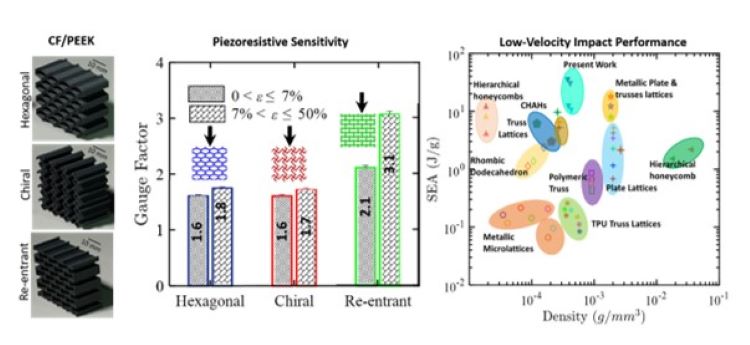
This is the claim of a Glasgow University-led team of engineers who have used 3D printing techniques to add new properties to PEEK (polyether ether ketone), which is known for its mechanical properties and resistance to high temperatures and chemicals. Their findings are published in Materials & Design.
The team added microscale carbon fibres to their cellular PEEK structures, giving the usually non-conductive material the ability to carry an electric charge.
3D-printed lithium-ion battery shows green potential
Plate-lattice metamaterial ‘tougher and lighter’ than aluminium
According to Glasgow University, they wanted to investigate whether damaging their electro-conductive cellular PEEK composite would affect its electrical resistance. If so, it could give the new material the ability to ‘self-sense’, which would allow a hip implant to report when its conductivity has changed, indicating that it has worn down and needs to be replaced.
To test their design’s self-sensing ability, they used 3D printing to create a hexagonal structure, a cross-shaped chiral structure, and a six-sided re-entrant design using the carbon-fibre PEEK material and conventional PEEK.
They then subjected the cellular structures to crush and impact tests. In crush tests each design of the carbon-fibre PEEK was outperformed by its conventional PEEK counterpart, which were able to withstand higher pressures.
In impact tests the three carbon-fibre PEEK structures demonstrated greater resistance to damage. The hexagonal honeycomb configuration of the carbon-fibre PEEK had the best response, withstanding greater impacts than any of the others.
In the crushing tests, the researchers also measured the carbon-fibre PEEK cellular structure’s resistance to an electric charge as the three different structures were strained. The change in resistance to applied strain - piezoresistive sensitivity - decreased as the compressive strain increased, leading to a near complete loss of electrical resistance when the structures were completely crushed. The different gauge factors observed for different configurations is associated with their rate of damage growth in accordance with their ability to absorb energy, suggesting that the piezoresitivity of carbon-fibre PEEK could be of benefit in creating a new generation of smart lightweight multifunctional structures.
Dr Shanmugam Kumar, of Glasgow University’s James Watt School of Engineering, is the corresponding author of the paper. Colleagues from Khalifa University in the United Arab Emirates and Cambridge University contributed to the research.
In a statement, Dr Kumar said: “The unique properties of PEEK have made it invaluable to many industrial sectors, and we hope that the carbon-fibre engineered PEEK cellular structures that we’ve been able to build via 3D printing will open up further possibilities.
“3D printing gives us a remarkable amount of control over the design and density of the cellular structure. That could allow us to build materials which more closely resemble the physiology of the native bone than the solid metal alloys traditionally used in medical implants like hip or knee replacements, potentially making them more comfortable and effective.
“We hope that these cellular forms of microengineered lightweight, self-sensing PEEK we’ve developed will find new applications in a wide range of fields, not just in prosthetics and other medical devices but also in automobile design, aerospace engineering, and the oil and gas sector.”
The research was supported by funding from Glasgow University and Khalifa University.





Glasgow trial explores AR cues for autonomous road safety
They've ploughed into a few vulnerable road users in the past. Making that less likely will make it spectacularly easy to stop the traffic for...